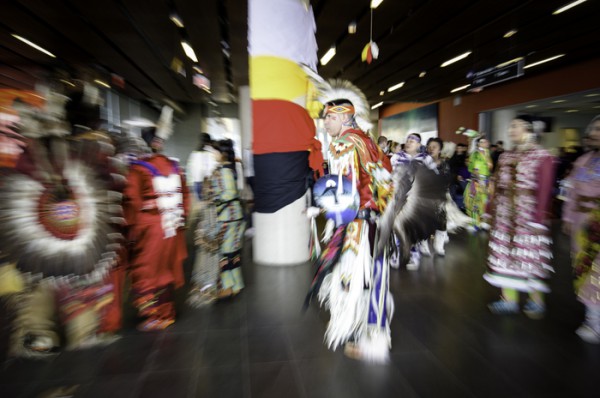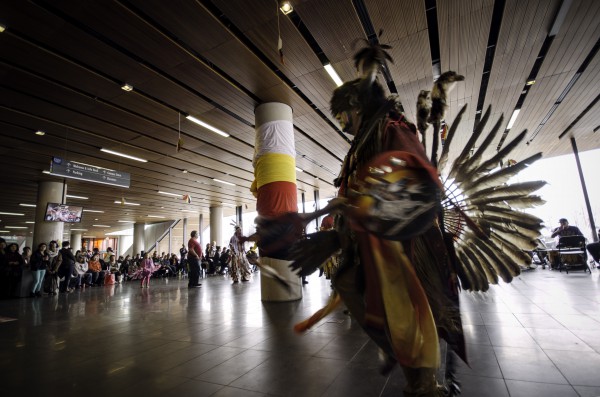Pow Wow brought singing, dancing and vibrant colours back to the Waterfront campus to celebration aboriginal culture

Men’s traditional dance at the 7th annual Four Sacred Colours Pow Wow at Waterfront campus
Photo: Keren Fan/The Dialog
The annual Four Sacred Colours Pow Wow took place on March 21, at George Brown College’s (GBC) Waterfront campus. This was the GBC’s 7th annual Pow Wow and had nearly 1000 guests attend to experience the Aboriginal culture.
“Pow Wow is an opportunity to share our culture, practice our culture and enjoy the friendship between one another,” said by Bob Goulais, master of the ceremonies for the event.
Put on by aboriginal services at GBC, the Pow Wow is a gathering for aboriginal people to meet, dance, and showcase the characteristics of their culture.
Many dancers came with their traditional regalia, handicrafts, and gifts to meet and share with each other, but more importantly, they came to celebrate this special day by dancing, drumming and singing.
Attracting people of all ages, elders and children made up a large portion of the guests and dancers.
Goulais introduced the Pow Wow as the Four Sacred Colours gathering. The Four Sacred Colours are equal, and each direction has a specific colour, specific meaning and specific teaching. The yellow, red, black and white symbolize East, South, West and North.
The central pillar in the lobby was covered with the four colours cloth, and all the dancers danced around it to the sound of drumbeats and singing.
Dancing was the main part of the event and every dancer wore different regalia for each dance.
For the men’s traditional dance, the men’s regalia had lots of feathers and colourful designs. Some of the men had painted their faces as well.
The women’s regalia was covered with golden bells and long tassels so that when they danced you could hear the sound of jingles, the jingle dance.

Dancers in traditional regalia for the men’s traditional and the women’s jingle dance
Photo: Keren Fan/The Dialog
“When we dance, we pray at same time. We celebrate life during the dance. We look around circle, pray for everybody to have a good and strong life,” said Bernard, a traditional dancer at the Pow Wow.
The dancers also believe that the women’s jingle dance can cure disease. People who are suffering from disease can get one kind of herbal medicine and put it on a dancer’s hand. The dancer will hold it and dance, and the people will get better.
”This is my third year attending the Pow Wow at our school. It is very meaningful because it was illegal to do it 156 years ago,” said Coty Zachariah, a volunteer at the event. “It’s very powerful to get community together like this.”
Jonathan Vukson, project development and employment transition liaison for GBC’s aboriginal services, said, “today is really important for us, and this year is special because it’s the 7th annual Pow Wow. Seven is a big number for our culture. Seven grandfather teachings and the 7th Pow Wow.”
Vukson also suggested that students visit the Sahkitchway room in 562D at St. James and the Wi Chi Hito Win room in 335D at Casa Loma campus, to learn more about first nation’s people here in Canada.


